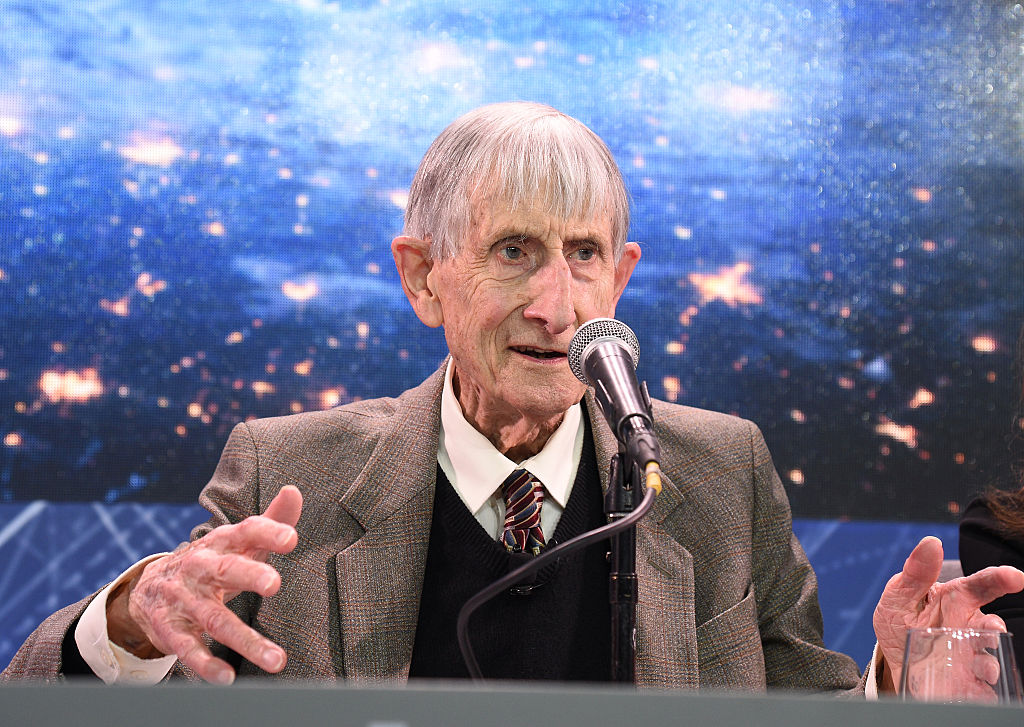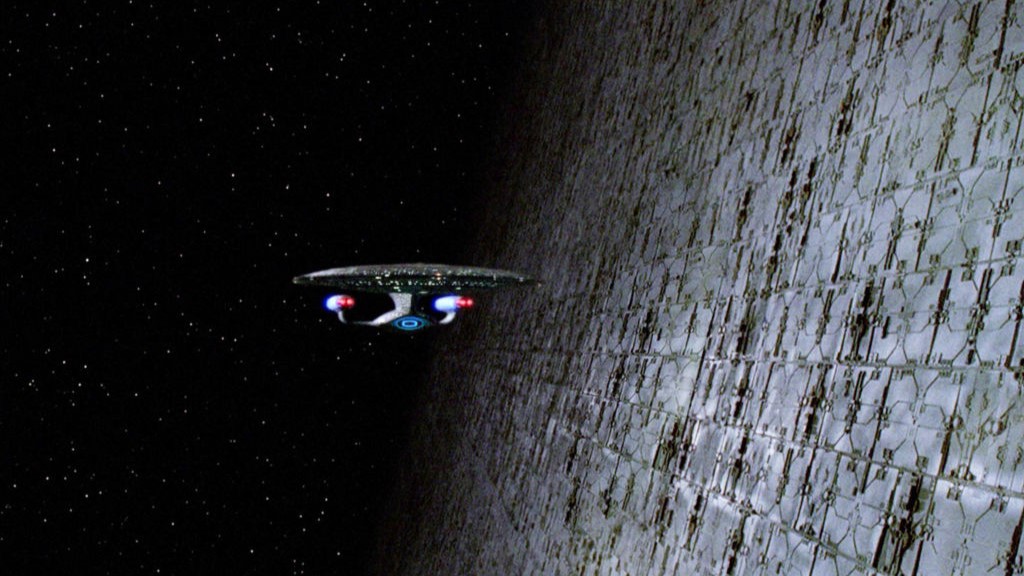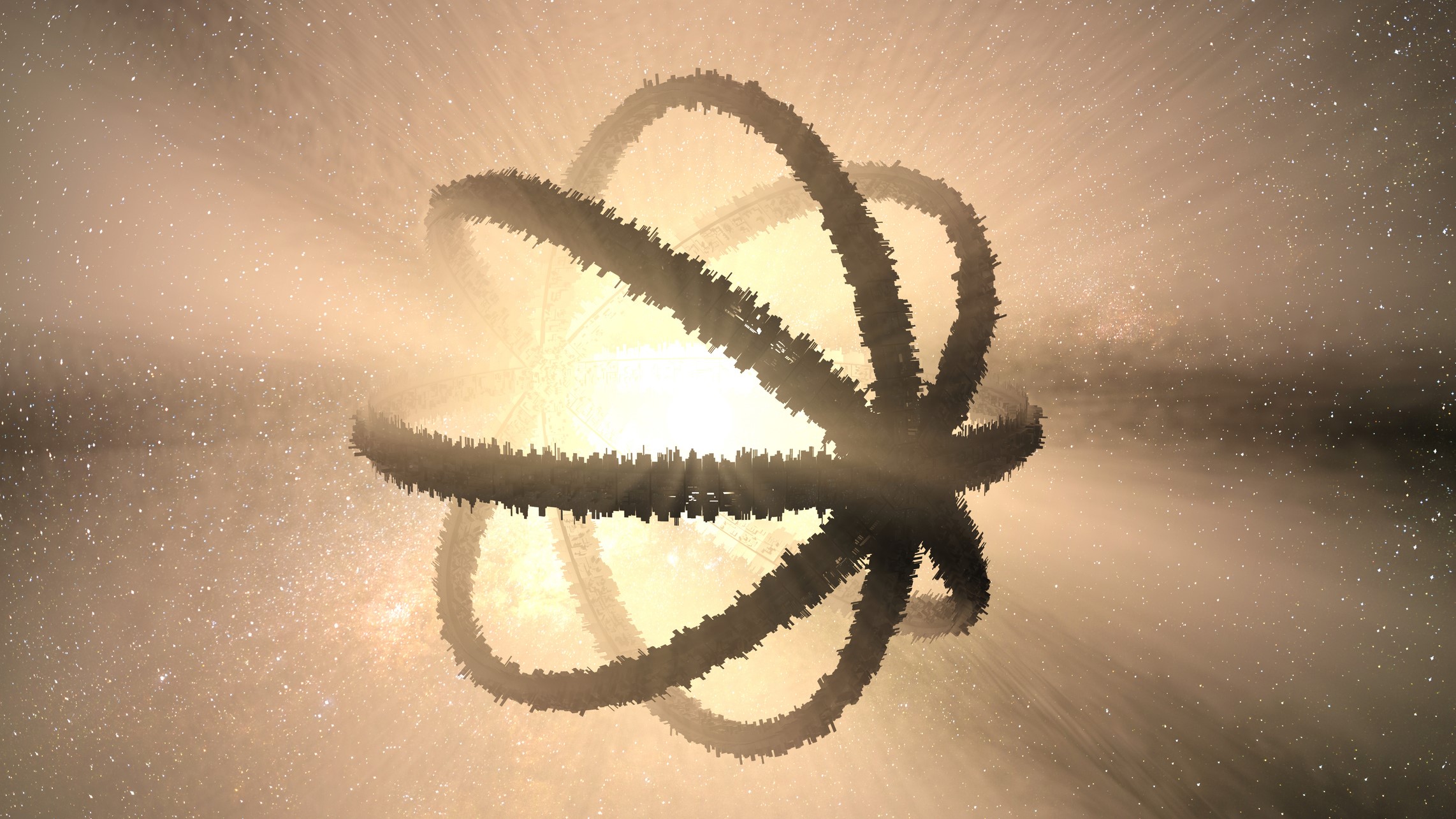What are Dyson spheres, and how do we look for them?
Dyson spheres are hypothetical artificial megastructures built around a star to collect all of its radiant energy.

Dyson spheres are hypothetical artificial megastructures built around a star to collect all of its radiant energy.
In theory, detecting a Dyson sphere could be a way to find a technologically advanced alien civilization that did not wish to communicate.
However, many challenges exist for both building and finding such Dyson spheres, also called Dyson swarms.
What is the theory of a Dyson sphere?
The idea behind a Dyson sphere is to collect as much energy from a star as possible. On Earth, the total amount of energy we receive from the sun — a value known as the total solar irradiance — is 1,361 watts per square meter, as measured by NASA's Solar Radiation and Climate Experiment. Yet that is just a tiny proportion of the sun's total energy output radiated in all directions, which is 380 billion quadrillion (3.86 x 1026) watts every second, according to the Australian Space Weather Forecasting Centre. Because Earth is so small by comparison, we receive only a tiny proportion of this energy.
Suppose, though, that an enterprising technological civilization wanted to make use of all their star's energy that would otherwise move off into space at the speed of light. If they had sufficiently advanced technology, they might build themselves a Dyson sphere — a spherical swarm of solar-energy collectors that would fully encapsulate their star and collect all of its energy.
Scientists who study the search for extraterrestrial intelligence (SETI) categorize a civilization with a Dyson sphere as a Kardashev Type II on the Kardashev scale, meaning it's capable of utilizing all the energy from a star, in the region of 1,026 watts per second. (This value varies from star to star, as some stars are more or less luminous than the sun.) A Type I civilization utilizes all of the energy available to a single planet — fossil fuels, renewable energy sources and nuclear power — which is calculated to be about 1,016 watts per second. And a Type III civilization utilizes all the power in an entire galaxy, by building Dyson spheres around every star and taking energy from the central supermassive black hole, and attains 1,036 watts per second.
If you're wondering where we rate on that scale, we're currently a Kardashev type 0.7449 civilization — we don't even make full use of all the energy available to us on Earth.
Breaking space news, the latest updates on rocket launches, skywatching events and more!
Dyson spheres FAQS
What is a Dyson sphere?
In 1960, physicist Freeman Dyson suggested that technological extraterrestrial civilizations might build a cloud of solar energy collectors that would completely surround their star and that would be detectable from its waste heat.
Is a Dyson sphere possible?
In theory, yes, a Dyson sphere is possible. However, the required resources, engineering skill and time it would take to build one may make it an insurmountable ambition.
How much would a Dyson sphere cost?
Assuming we could build a Dyson sphere, we'd have to dismantle an entire planet for the raw materials. That's not something we could put a cost on, but in theory, a Dyson sphere should be able to make its money back and much, much more in the amount of energy it generates.
Who invented the idea of the Dyson sphere?
As the name suggests, the concept of Dyson spheres was invented by the great physicist and polymath Freeman Dyson. But his idea, published in the journal Science in 1960, was inspired by several other sources, including Olaf Stapledon's 1937 science-fiction novel "Star Maker," according to an interview Dyson conducted with students at the University of Edinburgh. In the same interview, Dyson, who died in February 2020, described how the Dyson sphere concept arose out of asking the question "How could we detect a [technologically] advanced civilization that does not wish to communicate?" Dyson figured that looking for signs of immense artificial megastructures was the way to go about it.
Dyson had a varied and exciting career. Born in England, he studied at the University of Cambridge, moved to Cornell University in the early 1950s and then transferred to Princeton University, where he remained for the rest of his career. Dyson's research was varied, spanning topics such as quantum electrodynamics, nuclear-powered spacecraft (Project Orion), the origin of life, condensed matter physics and various mathematical problems.
Was there a Dyson sphere in "Star Trek"?
Although Dyson spheres and similar megastructures have appeared in science fiction both before and after Dyson's 1960 paper on the subject, possibly the most famous depiction is found in a 1992 "Star Trek: The Next Generation" episode called "Relics." In it, the crew of the Enterprise-D discovers a crashed Federation starship on the outer surface of a Dyson sphere, and preserved in the ship's transporter buffers is none other than Montgomery Scott — Scotty from the original "Star Trek." As the Enterprise explores the Dyson sphere, it becomes trapped inside, so Scotty and Geordi La Forge must rescue them.
The episode makes the common faux pas of depicting a Dyson sphere as a huge, solid shell of metal. In reality, a solid shell would be mechanically and dynamically unstable and vulnerable to impacts that could break it up. Any gravitational perturbations could also nudge it into the star that it surrounds, thereby destroying it.
Instead, Dyson clarified his original paper by saying that a swarm of small solar-energy collectors all around a star would be more viable than a giant, solid sphere, since even if one part of the swarm were damaged, the rest would be fine and individual sections could have thrusters to maintain their positions. Hence, a Dyson sphere is, more properly, a Dyson swarm.
How could a Dyson swarm be built?
In his original 1960 paper, Dyson performed a back-of-the-envelope, order-of-magnitude calculation and deemed that a civilization would have to dismantle a planet the size of Jupiter to have enough raw material to build a Dyson swarm. If we wanted to build a Dyson swarm in our solar system, however, Jupiter would be too far from the sun.
Instead, in a talk at the University of Oxford, astronomer Stuart Armstrong proposed that dismantling the innermost planet, Mercury, might work well and that it contains enough useful material to produce a spherical swarm of solar collectors in Mercury's orbit, with each collector having 245 grams per square meter (0.54 pounds per 3.2 square feet).
The process could be bootstrapped: Starting off small, the energy generated by a relatively small solar array could generate enough energy to power the mining of asteroids to build more solar arrays that would provide enough energy to start mining and dismantling Mercury. In this way, although a Dyson swarm seems unfeasible, construction would actually begin small and grow organically. Armstrong described how each new phase of construction, powered by the growth of each new cycle of mining and collecting solar energy, would become exponential.
How could we detect Dyson swarms?
Remember Dyson's original intent: to come up with a way of detecting technologically sophisticated extraterrestrial societies that are not already trying to communicate with us. But how can we detect a Dyson swarm when they have blocked and absorbed all of the light from their star?
That's where the second law of thermodynamics comes in: It describes how heat will always flow from a hotter object to a colder region. When the solar collectors in a Dyson swarm absorb radiation from the star they surround, they will become much hotter than the space around them. The second law of thermodynamics describes how these hot solar collectors will emit thermal energy — "waste heat," as described by Penn State astronomer and SETI scientist Jason Wright — into the colder space around them. In practical terms, this will prevent the solar collectors from overheating and melting.
The upshot is that a Dyson swarm should radiate in thermal infrared. To discover one, then, astronomers must detect an object in deep space that is emitting anomalous amounts of infrared radiation. The trouble is natural objects — for example, evolved red stars producing dust, planetary nebulas, or distant dusty galaxies — can mimic the signature of a Dyson sphere in the night sky. That means Dyson-swarm hunters must first rule out all possible natural explanations before claiming to have found an alien megastructure.
Have we found any alien megastructures?
The first searches for Dyson swarms were conducted in the 1980s with data from the Infrared Astronomical Satellite (IRAS). In 2009, Richard Carrigan, an astronomer at Fermi National Accelerator Laboratory, picked up the mantle, reviewing and reanalyzing the IRAS data. Carrigan identified 16 infrared sources that he thought were worthy of further investigation while adding the caveat that they are probably natural phenomena.
More recently, a program to search for Dyson swarms called Project Hephaistos, aided by machine learning, sifted through 5 million objects in the databases of NASA's Wide-field Infrared Survey Explorer (WISE), the European Space Agency's Gaia astrometric mission, and the Two Micron All-Sky Survey. It revealed seven candidate Dyson swarms that exhibited excess infrared emission. These swarms, if real, would be partial swarms that surround only part of their star.
However, these seven candidates were refuted by another group, who showed that at least some of the candidates are very close in the sky to some dusty background galaxies that have strong infrared emissions. Meanwhile, another survey of the same data found 53 candidates with interesting infrared emissions. Nevertheless, in all of these cases, natural phenomena are the most likely explanation and must be ruled out before anything is declared a Dyson swarm.
Case in point: Boyajian's star, aka Tabby's star or KIC 8462852. Found by astronomer Tabetha Boyajian, the star exhibits many unusual transits, as though a swarm of objects were orbiting it. At times, 22% of the star's light was blocked, compared with the 1% that a Jupiter-size gas giant would block while transiting.
There was much discussion about whether these strange transits were being caused by an alien megastructure such as a partial Dyson swarm. In the end, the dips in starlight were explained as being caused by clouds of dust, possibly from an evaporating, orphaned exomoon or an exocomet.
Of course, our galaxy is not the entire universe. Even if there are no other technological civilizations in the Milky Way, there are 2 trillion more galaxies out there — so perhaps there is a technological civilization out there somewhere that is building Dyson swarms.
While individual Dyson swarms would be undetectable at intergalactic distances, an entire galaxy full of them would be detectable. Such a galaxy-spanning civilization, with Dyson swarms around every star in the galaxy, would be a Kardashev Type III civilization. Although a survey with WISE failed to find any, it left open the possibility of galaxies where only a fraction of the stars have Dyson swarms.
Of course, it is entirely possible that aliens, if they exist, don't build Dyson swarms. Perhaps it takes too long or requires too many resources, or endless growth through energy consumption is no longer an aim for them. The concept of a Dyson swarm is, after all, only a 20th-century human idea.
Q&A with an expert

Erik Zackrisson is an associate professor in the Department of Physics and Astronomy at Uppsala University in Sweden, about his work searching for Dyson swarms for Project Hephaistos.
The Project Hephaistos team found seven partial Dyson swarm candidates with unusual infrared excess. What is the next step in verifying them?
We already have optical spectra from follow-up observations for some of these candidates. These spectra indicate that the objects are normal red dwarfs without any obvious sign of youth, which could otherwise possibly explain the infrared excess. New midinfrared imaging with [the] James Webb Space Telescope (JWST) or sub-millimeter maps from ALMA [the Atacama Large Millimeter/submillimeter Array] could tell us whether we are seeing a single object or a superposition of two, as in the case where the infrared excess comes from a background object.
However, provided that the optical and mid-infrared flux is coming from the same object, then one really needs to do midinfrared spectroscopy to pin down the nature of the infrared excess. If the excess is due to dust, then one expects to see emission features that reflect the composition of the dust. On the other hand, if the excess is caused by a Dyson sphere, we expect to see pure continuum radiation. JWST's Mid-Infrared Instrument would be the perfect instrument for this.
There was a rebuttal paper that suggested the candidates are background contamination from dusty galaxies. Do you agree that this is a possibility?
For the cases where radio is detected, I completely agree. For the cases where no radio source has been detected, I think the situation is less clear-cut.
In 2018, you wrote a paper about how a star with a Dyson swarm around it may appear much farther away because of how red it is compared to its distance measured through parallax and that Gaia could be used to find these distance mismatches. Could this method help with regard to the candidates found by Project Hephaistos?
In general, it would be very useful to have additional diagnostics beyond the infrared excess, but the problem with the distance mismatch diagnostic is that it only works for Dyson swarms with very high covering fraction (i.e., an almost complete sphere). Hence, it is not very useful for our current candidates.
Dyson swarm searches are looking for a very specific form of engineering, but since we don't really know what ET might do and build, could we be missing other types of technosignatures? Could simply looking for deviations and anomalies from natural laws be a good way to search for technosignatures without making assumptions about them?
Looking for outliers of one type or another in large datasets could be a viable method to probe extreme astrophysics, new astrophysical phenomena and, in principle, artificial astro-engineering. However, one needs to keep in mind that the vast majority of outliers tend to be due to poor, faulty or ambiguous data — so trying to find something truly interesting using this method can be quite hard work.
Additional resources
See how Dyson spheres could be built, as well as their properties, via Oxford researcher Anders Sandberg's Dyson sphere FAQ page. Learn about NASA's commitment to investing in the search for technosignatures, including Dyson swarms. Explore the history of NASA's Wide-field Infrared Survey mission, which has been used for several searches for Dyson swarms.
Bibliography
Solar Irradiance, NASA, 2018, https://sunclimate.gsfc.nasa.gov/article/solar-irradiance
John Kennewell and Andrew McDonald, The Solar Constant, Australian Space Weather Forecasting Centre, https://www.sws.bom.gov.au/Educational/2/1/12
Robert H. Gray, The Extended Kardashev Scale, The Astronomical Journal, 159, 228, 23 April 2020, https://iopscience.iop.org/article/10.3847/1538-3881/ab792b
N. S. Kardashev, Soviet Astronomy–AJ, 8, 2, Sept–Oct 1964, https://adsabs.harvard.edu/full/1964SvA.....8..217K
Antong Zhang, Jiani Yang, Yangcheng Luo and Siteng Fan, Forecasting the Progression of Human Civilization on the Kardashev Scale through 2060 With a Machine Learning Approach, Scientific Reports, 13, 11305 (2023) https://www.nature.com/articles/s41598-023-38351-y
Freeman J. Dyson, Search for Artificial Stellar Sources of Infrared Radiation, Science, 131, 3414, pp. 1667–1668, 3 June 1960, https://www.science.org/doi/10.1126/science.131.3414.1667
Austin A. Morris, 'Maker of Patterns: An Interview with Freeman Dyson' University of Edinburgh, 2017 https://blogs.ed.ac.uk/physics-astronomy/wp-content/uploads/sites/180/2018/11/Interview-with-Freeman-Dyson.pdf
George Dyson, 'Freeman John Dyson, 15 December 1913–28 February 2020', Biographical Memoirs of Fellows of the Royal Society, 1 June 2022, https://royalsocietypublishing.org/doi/10.1098/rsbm.2021.0050
Star Trek: The Next Generation — Relics, IMDb, https://www.imdb.com/title/tt0708764/\
Jack Smith, 'Review and Viability of a Dyson Swarm as a Form of Dyson Sphere', Physica Scripta, November 2022, https://iopscience.iop.org/article/10.1088/1402-4896/ac9e78
Freeman J. Dyson, 'Response: Artificial Biosphere', Science, Vol 132, Issue 3421, pp 252–253, 22 July 1960, https://www.science.org/doi/10.1126/science.132.3421.252.b
Stuart Armstrong, 'Von Neumann Probes, Dyson Spheres, Exploratory Engineering and the Fermi Paradox', YouTube, 2012, https://www.youtube.com/watch?v=zQTfuI-9jIo
Second Law of Thermodynamics, NASA Glenn, May 2021, https://www.grc.nasa.gov/www/BGH/thermo2.html
Jason T. Wright, 'Application of the Thermodynamics of Radiation to Dyson Spheres as Work Extractors and Computational Engines and Their Observational Consequences' The Astrophysical Journal, 956, 34, 2023, https://iopscience.iop.org/article/10.3847/1538-4357/acf44f
Jason T. Wright, 'Dyson spheres', Serbian Astronomical Journal, No. 200, 1–18 (2020), https://saj.matf.bg.ac.rs/200/pdf/001-018.pdf
Richard A. Carrigan, 'IRAS-Based Whole-Sky Upper Limit on Dyson Spheres', The Astrophysical Journal, 698, pp2075–2086 (2009), https://iopscience.iop.org/article/10.1088/0004-637X/698/2/2075/pdf
Matías Suazo et al, 'Project Hephaistos — II. Dyson sphere candidates from Gaia DR3, 2MASS, and WISE', Monthly Notices of the Royal Astronomical Society, Vol 531, issue 1, pp695–707, (2024) https://academic.oup.com/mnras/article/531/1/695/7665761
Tongtian Ren, Michael A. Garrett, Andrew P. V. Siemion, 'Background Contamination of the Project Hephaistos Dyson Spheres Candidates', Research Notes bof the AAS, 8, 145, (2024) https://iopscience.iop.org/article/10.3847/2515-5172/ad5017
Gabrielle Contardo and David Hogg, 'A Data-Driven Search For Mid-Infrared Excesses Among Five Million Main-Sequence FGK Stars', 2024, https://arxiv.org/abs/2403.18941
T. S. Boyajian et al, 'Planet Hunters X. KIC 8462852 - Where's the Flux?', Monthly Notices of the Royal Astronomical Society, 457, 4 (2016),'https://academic.oup.com/mnras/article/457/4/3988/2589003
Bradley E. Schaefer et al, 'The KIC 8462852 light curve from 2015.75 to 2018.18 shows a variable secular decline', Monthly Notices of the Royal Astronomical Society, 481, 2 (2018), https://academic.oup.com/mnras/article/481/2/2235/5045268
Miguel A. S. Martinez et al, 'Orphaned exomoons: Tidal detachment and evaporation following an exoplanet–star collision', Monthly Notices of the Royal Astronomical Society, 489, 4 (2019), https://academic.oup.com/mnras/article/489/4/5119/5561511
Steven D. Young and Mark C. Wyatt, 'The eccentric Koza–Lidov mechanism as the cause of exocomet transits of KIC 8462852', Monthly Notices of the Royal Astronomical Society, 527, 3, (2024) https://academic.oup.com/mnras/article/527/3/5244/7285819
Christopher Conselice et al,'The Evolution of Galaxy Number Density at z<8 and its Implications', The Astrophysical Journal, 830, 83 (2016), https://iopscience.iop.org/article/10.3847/0004-637X/830/2/83
Jason T. Wright at al, 'The Ĝ Infrared Search for Extraterrestrial Civilizations with Large Energy Supplies II: Framework, Strategy and First Result', The Astrophysical Journal, 792, 1 (2014), https://iopscience.iop.org/article/10.1088/0004-637X/792/1/27/meta
Erik Zackrisson et al, 'SETI with Gaia: The Observational Signatures of Nearly Complete Dyson Spheres', The Astrophysical Journal, 862, 1 (2018), https://iopscience.iop.org/article/10.3847/1538-4357/aac386

Keith Cooper is a freelance science journalist and editor in the United Kingdom, and has a degree in physics and astrophysics from the University of Manchester. He's the author of "The Contact Paradox: Challenging Our Assumptions in the Search for Extraterrestrial Intelligence" (Bloomsbury Sigma, 2020) and has written articles on astronomy, space, physics and astrobiology for a multitude of magazines and websites.




